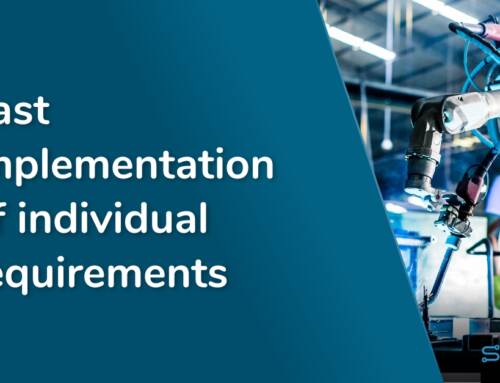Every company wants one, hardly any company has one and when it exists it’s a secret: a thoughtful strategy making companies able to face the challenges of digital transformation. A reason might be the various definitions about the characteristics of such a strategy, how detailed it needs to be and which questions it needs to answer. For some companies a “digital strategy” is nothing more than thinking about how to use their Social Media channels, others try to develop and implement completely new business models.
What does digital strategy mean?
At this point we know that digital strategy can have different meanings for every company, that’s why we’ll give a definition for this post at first.
A digital strategy includes all actions a company needs to reinvent themselves digitally along the whole value chain.
The example of the digital factory – the self controlling production – seems to be quite extreme at first sight but in fact, it’s possible to digitize and automate all processes within a production company. But of course one has to ask the question how much sense this will make – even in future. The basis for such an answer always is the analysis of cost and benefit. In the best case all questions regarding digitization depth and rewarding investments are answered within a digital strategy.
Which areas should furthermore be covered?
- Organization of internal processes
- Customer communication and loyalty programmes
- Digital transformation of existing products
- New, digital business models
Why is it so hard to develop a really good digital strategy?
Most companies struggle when it comes to developing a digital strategy. One of the most important reasons for this is the continuous development of new technologies. It’s hard to keep the overview and evaluate those new technologies again and again to find out which one is the best solution. Especially bigger companies suffer from historically grown structures on process and system side. So, it’s nearly impossible to see through the chaos, especially when departments implement own solutions for special projects without asking or informing internal IT-department. To develop a really successful digital strategy numerous experts have to come together to find a common solution fitting everybody’s needs. But of course every department represent their own special interests which often isn’t helpful for finding a common solution.
8 Tips how to develop a digital strategy
1. Phrase aims, not solutions
By formulating overriding goals, you create the necessary mental flexibility for yourself.
Marketing example: We need to do more advertising (solution approach)
Better would be to define the following goal here: We need within the next 6 months 20% more orders (goal).
The measure advertising to switch is here only a possible solution around the defined goal to arrive. Further solutions can be defined and executed with this goal in mind.
2. Create the necessary conditions
The most necessary conditions for successful digital transformation on the one hand are the technical requirements like IT infrastructure and security mechanisms on the other hand awareness and enthusiasm for digital solutions which make employees want to change something.
3. Analyze your existing processes
Have a look at your existing processes and analyze where the potentials are particularly high.
- at which point time is spent with manual tasks or system maintenance
- where are the highest error rates that require time- and cost-consuming rework
- where are resources blocked with jobs that also could be automated
Key figures only are one important tool for analysis, employee surveys also help to identify weak points that can be eliminated when creating a now solution.
4. Make data available
The basis of any digitization is data, so make sure that information about all activities in the company is available quickly. Within the digitization of your company, this data can be linked and evaluated. This often results in verifiable conclusions that result in extensive process optimizations. The degree of optimization is essentially dependent on the number and quality of the digitally available data.
5. Define the perfect way
What’s the perfect way for you? Define the solution the way you want it and don’t let yourself be limited to existing processes or system boundaries. This freedom in thinking often leads to better solutions than trying to optimize existing processes.
6. Find your way to perfection
Analyze different ways to achieve your goal. Ask yourself if only digital support is needed or if processes must be optimized additionally. Information processing and networking plays an important role here.
7. Stay flexible
When defining your strategy keep in mind that your company will change during realization. Calculate plans for new and digital business models and gain knowledge you can use for further projects. According to size and structure of the projects there are different requirements concerning IT. When implementing mobile assistance systems the quality of radio network and the amount of transferred data is crucial.
8. Start small
Even when your digital strategy has revealed enormous potentials, don’t start to digitally transform all over simultaneously. Start one project and use the knowledge for further ones. A highly flexible and growable solution for digitization you create the basis for intelligent, automated and self-optimizing systems.
Implementation of the strategy in practice
No matter how good a strategy may be, without an appropriate tool the result will never be satisfactory. Due to the challenges facing companies today, special digitization tools have been developed. These offer enormous advantages in terms of speed, usability and maintainability of the applications created – low code is the key to success.
Read on to see what benefits low-code brings to you as:





